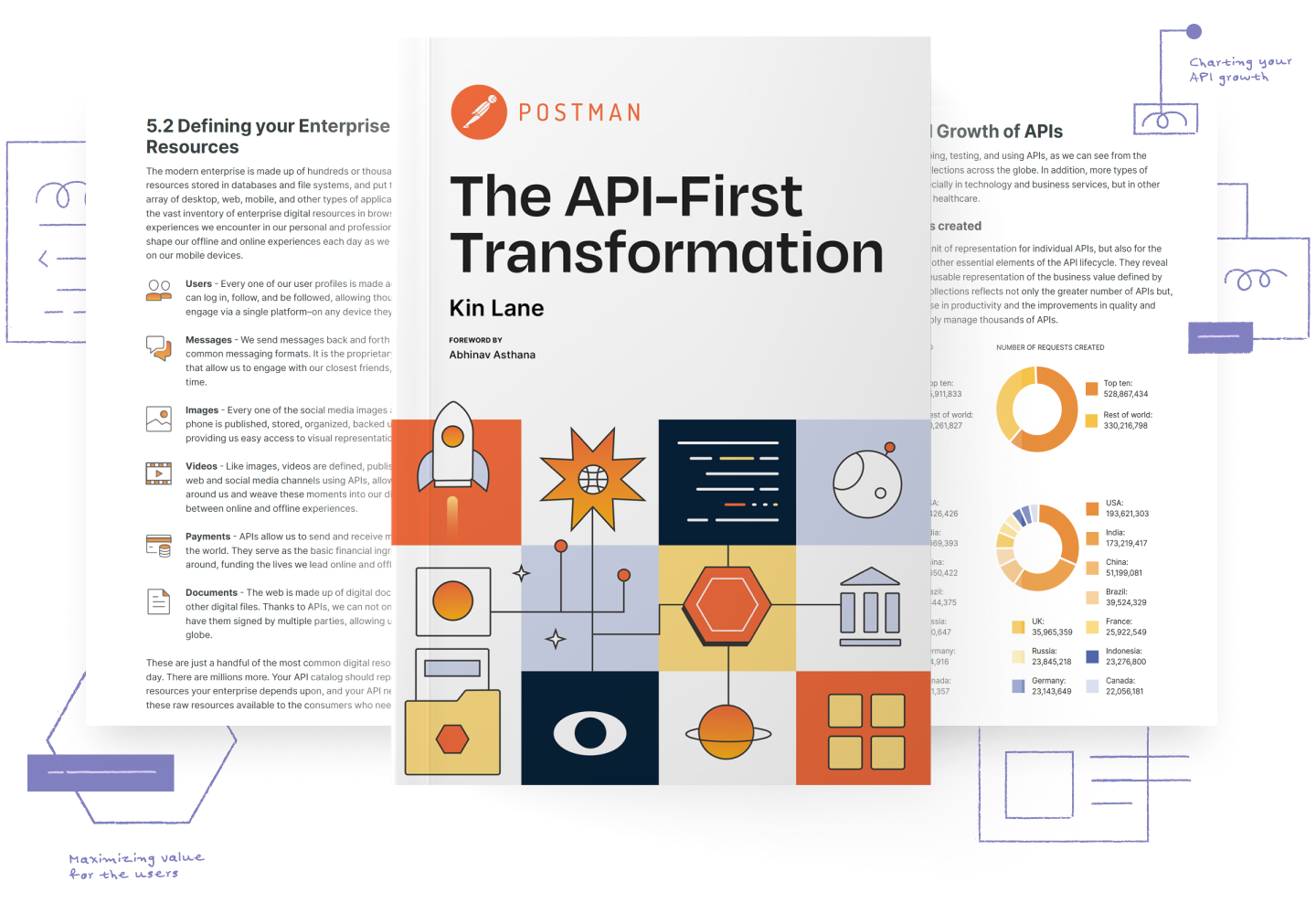API ファーストのガイド
API、つまりアプリケーション・プログラミング・インターフェイスは、現代のコンピューター技術とほぼ同じくらい古くから存在しています。API は数十年前に、異なるソフトウェアアプリケーション間の通信を可能にする手段として登場しました。そして、現在もその役割を果たしており、コンピューター、電話、スマートデバイスが相互に接続する際に、バックグラウンドで目に見えない形で動作しています。
しかし、API は単なるインターフェースの役割を超えて進化しています。過去 10 年間で、API は現代のソフトウェアとビジネスの基盤になりました。Amazon.com や Netflix のようなテクノロジーの先駆者であろうと、100 年の歴史を持つ食料品チェーンや連邦政府機関であろうと、組織は API を使用して外部に新しいサービスを提供し、内部で効率化を実現しています。
テクノロジーユーザーが複数のデバイスにまたがるエクスペリエンスを求めているという新たな現実も、API の成長に反映されています。ユーザーは、データやサービスが即座に利用可能になり、プラットフォーム間で共有できることを期待しています。つまり、社外の顧客にサービスを提供している場合でも、社内の従業員にサービスを提供している場合でも、あらゆるビジネスは事実上ソフトウェアビジネスであるということです。
テクノロジーと組織のエコシステムをつなぐ結合体として、API は企業がデータを収益化し、有益なパートナーシップを築き、イノベーションと成長のための新たな道を開くことを可能にします。
API ファーストとは?
API ファーストアプローチでは、ソフトウェア開発プロセスの最初の段階で API を優先し、API をソフトウェアの構成要素として位置付けます。API ファーストの組織では、API を後回しにするのではなく、他のコードを書く前に API を開発します。これにより、チームは API を通じて提供される内部および外部のサービスを使用してアプリケーションを構築できます。
API ファースト企業とは、API ファースト開発モデルを採用している組織のことです。
API ファーストのしくみは?
組織が API ファースト開発モデルを採用するには、API に重点を置き、組織内でのパブリック API、プライベート API、パートナー API の役割を認識して、API ファーストになるために必要なツールと API ライフサイクルを理解する必要があります。

API ファーストアプローチ: API に重点を置く
最も先見の明のある企業は、ソフトウェア開発に API ファーストのアプローチを採用しています。開発者はコードを書き始める前に、まずビジネス部門と協力して API を設計または構築します。このようにすることで、基盤となるアプリが社内外のアプリケーションとシームレスに接続できるようになります。また、ア�プリの機能が拡張され、パートナーやエンドユーザーがアクセスできるようになります。
API ファーストであるということは、単一のアプリケーションを急いで提供し、後から API を作成するのではなく、アプリケーションをサポートする API を優先し、ビジネスに提供できる価値に重点を置くことを意味します。この先進的なアプローチにより、API を介して、アプリケーションをビジネスのさまざまな部門で複数の用途に採用できるようになります。
API は一度で完了するプロジェクトではありません。API は、維持および改善が必要な、重要な構成要素です。企業はこのことを認識し、それをサポートするチームを構築しています。
プライベート API、パートナー API、パブリックAPI
API といえば、多くの人が最初に思い浮かべるのは eBay や Stripe といった企業のパブリック APIでしょう。これらの API は、何百万もの中小企業の成長を助け、何千億ドルもの価値のある強力な技術プラットフォームを生み出してきました。
しかし、ソフトウェア開発者がほとんどの労力を費やすのはプライベート API、つまり内部 API です。実際、37,000 人を超えるプロフェッショナルを対象に調査した Postman の 2022 年 State of the API レポートによると、開発者が扱う API の 58% は社内専用です。
プライベート API を使用すると、クラウドに保存されているものも含め、さまざまなアプリケーションでデータを共有し、実用的な分析情報を提供できます。この作業の多くは自動的に実行できるため、組織全体のあらゆる階層の従業員に情報を公開できます。
一度構築されたプライベート API は、ビジネス全体で再利用できるため、配信が高速化され、貴重な開発者リソースが節約されます。
組織のニーズが拡大し、ビジネスパートナーとのやり取りが必要になると、パートナー API が役立ちます。パートナー API を使用すると、組織は特定のユーザーや顧客と API を共有できるため、コラボレーション、ビジネスパートナーシップの構築、対象を絞ったフィードバックの収集の機会が得られます。State of the API レポートによると、パートナー API は組織の API の 27% を占めています。
State of the API レポートによると、パブリック API、つまりウェブ上で誰でも自由に利用できる API は、組織の API の約 15% を占めています。
全体として、組織は API にどれだけの労力を費やしているのでしょうか?開発者の約 51% が、組織の開発労力の半分以上が API に費やされていると回答しています。

API ライフサイクル
API プラットフォームでの運用を最大限に活用し、さまざまなチームにまたがる数百、数千もの API を効果的に管理するには、適切に定義された API ライフサイクルが不可欠です。
組織全体で API ライフサイクルについての理解を共有し、それを説明するための共通の語彙を持つことで、API を開発する際にチーム全員が同じ認識を持てるようになり、企業の推進に必要な生産性、品質、ガバナンスが向上します。
私たちは、Postman の世界中のユーザーに見られる最も一般的なステップに基づいて、API ライフサイクルを 8 つのステージに分類しました。API の種類、そしてそれが新規か既存かによって、チームのライフサイクルのエントリポイントは異なるかもしれません。
API プラットフォーム
API プラットフォームは、提供者と利用者が API を構築、管理、公開、利用できるようにするツールとプロセスが統合されたソフトウェアシステムです。API ファーストを実現する重要な要素であり、次の 4 つの主要コンポーネントがあります:
API クライアント、API 設計とモック機能、API テストと自動化、API ドキュメント、API モニタリングなど、API ライフサイクルのためのツール
API カタログや API ワークスペースなど、提供者と利用者のコラボレーション機能
API セキュリティやオブザーバビリティなど、運用、アーキテクチャ、セキュリティチーム向けのガバナンス機能
ソースコード管理、CI/CD、クラウド/オンプレミスインフラストラクチャ、アプリケーションパフォーマンス管理などのソフトウェア開発ライフサイクルとの連携
なぜ API ファーストなのか?
API ファースト開発モデルを採用すると、開発者と組織の両方に大きなメリットがもたらされます。
開発者にとっての API ファーストの価値
API ファーストのアプローチは、より強力で回復力のあるソフトウェアを生み出すだけでなく、より短時間でそれを実現します。これにより、開発者の仕事が楽になり、並行して作業できるようになり、他の人のコードのデバッグに費やす時間が短縮されます。
開発者は、既存のソフトウェアを作り直すのではなく、イノベーションに集中できます。また、API により、開発者は使いたいテクノロジー、プラットフォーム、プログラミング言語を選ぶことができるようになります。
結局のところ、これは API ファースト企業の開発者の満足度が高まることを意味します。私たちの State of the API 調査では、回答者の少なくとも 75%が、API ファースト企業の開発者はより幸せであり、新製品をより早くリリースし、セキュリティリスクをより早く排除し、より優れたソフトウェアを作成し、生産性が高いことに同意しています。
API ファーストにより、開発者以外のユーザーもアプリを構築できるようになります。State of the APIレポートによると、API に携わる人の約半数は、ビジネスアナリスト、プロダクトマネージャー、CEO などの職務に就いています。この傾向により、利用可能なサービスやソフトウェアの世界が大幅に拡大しています。
API プラットフォームが進化するにつれて、コードの知識がなくても、一般的なアプリを構築し、テストや連携を実施し、データを転送できるようになるでしょう。
企業にとっての API ファーストの価値
API が現代のソフトウェアの構成要素になりつつある今、API ファーストのアプローチを採用する利点は数多くあります。これは特に
開発者生産性の向上
組織が API ファースト開発モデルを採用すると、開発者と製品チームは API ライフサイクル全体にわたってより迅速なコラボレーションを行い生産性を向上させることができます。このアプローチでは、開発者は API 作業が一元管理される共通のワークスペースを作り、生成物、ドキュメント、モックサーバー、環境��、テスト、モニター、履歴、その他チームメンバーが必要とするあらゆるのものを保有できるようにします。API とマイクロサービスの設計、開発、デプロイ、運用を最適化する反復可能なプロセスが確立されます。
ソフトウェア品質の向上
開発者にとっての API ファーストの価値は、開発者がより短時間でより強力で回復力のあるソフトウェアを開発できるようになることであり、品質の向上に直接つながります。API ファーストのアプローチにより、バグは本番環境に到達する前に取り除かれ、品質エンジニアが問題をより早く発見し、セキュリティエンジニアが協力してより早く強固なセキュリティを実現できるため、運用、品質、セキュリティのどのエンジニアリングチームも品質の向上を確認できるようになります。また、API ファーストのアプローチにより、これらの基盤チームは開発チームと直接かつ効果的にコラボレーションすることができるようになります。
コンプライアンスとガバナンスの簡素化
アーキテクトは、プライベート API ネットワークを通じて一貫した方法で API ランドスケープ全体を整理および管理することができ、設計・開発段階で設計やガバナンスのルールを挿入することができます。
API ファーストのアプローチでは、発見のしやすさとオブザーバビリティが運用のデフォルトの一部として提供されるため、規制要件や問い合わせへの対応に伴う手間を減らすことができます。
また、API ファーストにより業務全体が見通せるようになり、API の設計に一貫性があるところとないところを理解するのに役立ちます。API ガバナンスとは、複雑な企業システムの状態を理解し、正しい方向に進むために必要な変更を更新し、ガイドを提供して、実現するための制御と影響力を持つことです。
強固な API セキュリティ境界の提供
API ファーストのセキュリティ境界は、ファイアウォールや既存のアプリケーションセキュリティプラクティスだけよりもはるかに効果的です。あらゆる API とマイクロサービスには、セキュリティの専門家によって一元的に定義されたセキュリティコレクションがありますが、開発者の通常の API 開発ライフサイクルの一部としても適用されます。
最も単純な API であっても、バージョンごとにデプロイまたは変更される際に、最小限のセキュリティスキャンと評価が強制的に実行されます。アプリケーションが何であるか、利用者が API をどのくらいの期間使用するかに関係なく、チームが利用するすべての API に一貫してセキュリティが適用されます。

競争優位性としての API ファースト
あらゆるビジネス分野の企業組織が API の重要性に気づき始めています。しかし今日、世界中でビジネスをリードし、形作っているのは、API ファーストを採用した企業です。
API ファーストのアプローチを API プラットフォームと組み合わせて採用すると、その利点は何倍にもなります。現時点では、API を採用したいかどうかではなく、API ファーストであるかどうかが重要になります。
あなたの会社は API ファースト企業ですか?
API ファースト企業は、以下の質問すべてに「はい」と答えます:
- ほとんどのデータを操作するための API はありますか?
- 顧客やパートナーに API を公開していますか?
- API を整理して発見する方法をご存知ですか?
- API を構築するプロセスを標準化していますか?
- API は規制要件を満たしていますか?
- API 境界のセキュリティリスクをご存知ですか?
これらの質問すべてに「はい」と答えられなかった方は、API ファーストになる方法を学ぶために、この先を��お読みください。
API ファーストになるための 5 つのステップ
API ファースト企業になるための最初のステップは次の通りです:
- データベース、アプリケーション、サービスの一覧表を作成し、API がいくつあるか、どこに API が不足しているかを正確に把握します
- 組織の API 作成アプローチを理解し、標準プロセスが存在する場所と存在しない場所を特定します
- ビジネスドメインの境界を定義し、その境界に組織構造をマッピングします
- API プラットフォームを採用し、標準化します
- エンジニアリングチーム、DevOps チーム、製品管理チームに API ファーストを教育します
API ファーストへの道を探る
API ファーストにすることで、開発者チームの苦労が軽減され、組織の時間と費用も節約できます。しかし、API ファーストに至る有効なルートはいくつもあります。いったいどれが正しいのでしょうか?代表的なものをいくつか挙げてみましょう:
設計主導
これは API ファーストの旅に乗り出す多くのチームにとって、進むべき方角の指標になります。API 設計ファーストとは、コードを書いたり、何かを本番環境にリリースしたりする前に、協力して API を設計することです。
コード主導
API を利用するアプリケーションをコーディングする前に、API のコーディングを優先します。
プロトタイプ主導
OpenAPI 定義を作成する前に、コレクションを使用して API を開発し、モックやドキュメントを作成します。また、プロキシや Postman インターセプターを使用して API をリバースエンジニアリングし、コレクションを作成して、最終的にコレクションから OpenAPI を作成することも一般的です。
プロキシ主導
API プロキシまたは Postman インターセプターを介して既存の API を実行し、既存のトラフィックに基づいてコレクションを生成します。
コレクション主導
これには、既存の API 用の Postman コレクションを昔ながらの手作業で作成し、そのコレクションから OpenAPI を作成することが含まれます。
The API First Transformation はこちら
キン・レーン氏の著書「The API First Transformation」は、ビジネスリーダーがどのように API ファースト戦略を構築し、適切なテクノロジーを組み立て、どのようにソリューションを機能させるかを示しています。
